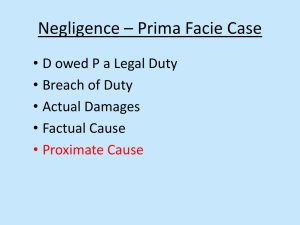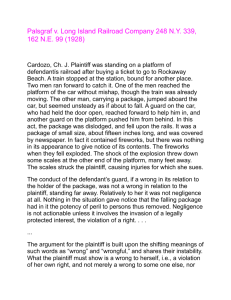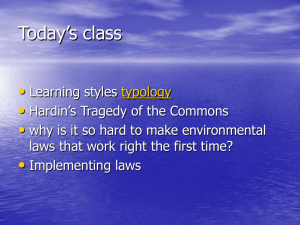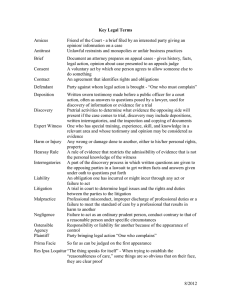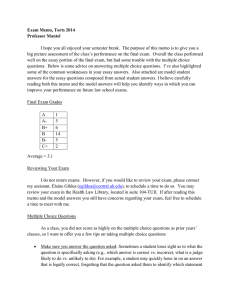using the “but for” and/or proximate cause tests.
advertisement
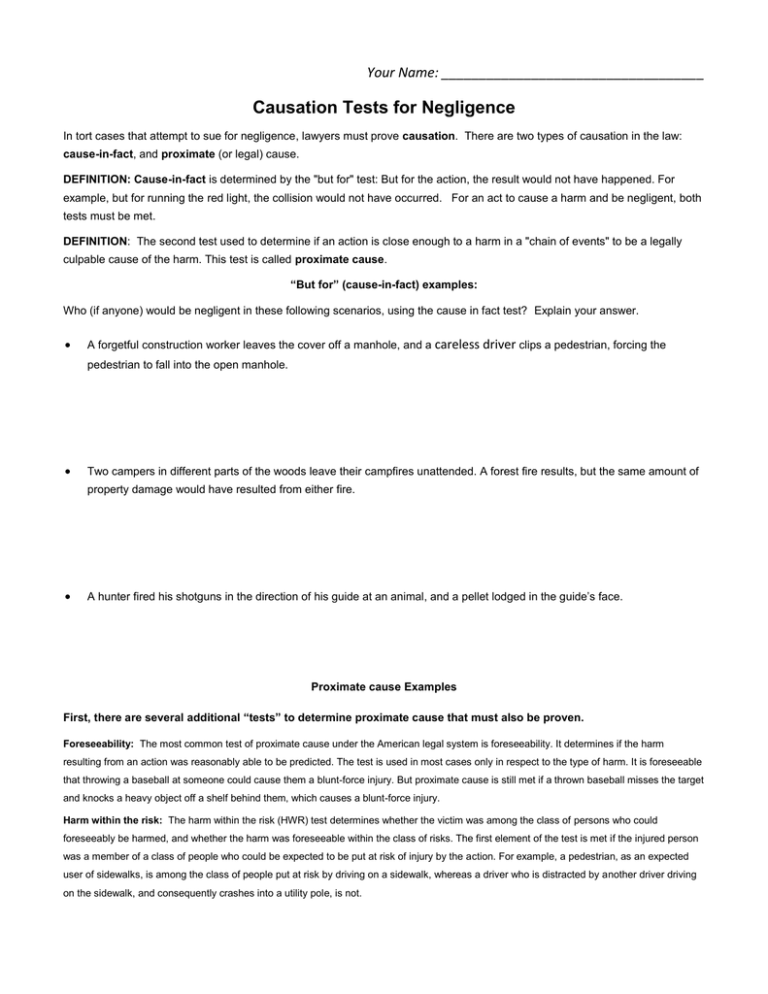
Your Name: ___________________________________ Causation Tests for Negligence In tort cases that attempt to sue for negligence, lawyers must prove causation. There are two types of causation in the law: cause-in-fact, and proximate (or legal) cause. DEFINITION: Cause-in-fact is determined by the "but for" test: But for the action, the result would not have happened. For example, but for running the red light, the collision would not have occurred. For an act to cause a harm and be negligent, both tests must be met. DEFINITION: The second test used to determine if an action is close enough to a harm in a "chain of events" to be a legally culpable cause of the harm. This test is called proximate cause. “But for” (cause-in-fact) examples: Who (if anyone) would be negligent in these following scenarios, using the cause in fact test? Explain your answer. A forgetful construction worker leaves the cover off a manhole, and a careless driver clips a pedestrian, forcing the pedestrian to fall into the open manhole. Two campers in different parts of the woods leave their campfires unattended. A forest fire results, but the same amount of property damage would have resulted from either fire. A hunter fired his shotguns in the direction of his guide at an animal, and a pellet lodged in the guide’s face. Proximate cause Examples First, there are several additional “tests” to determine proximate cause that must also be proven. Foreseeability: The most common test of proximate cause under the American legal system is foreseeability. It determines if the harm resulting from an action was reasonably able to be predicted. The test is used in most cases only in respect to the type of harm. It is foreseeable that throwing a baseball at someone could cause them a blunt-force injury. But proximate cause is still met if a thrown baseball misses the target and knocks a heavy object off a shelf behind them, which causes a blunt-force injury. Harm within the risk: The harm within the risk (HWR) test determines whether the victim was among the class of persons who could foreseeably be harmed, and whether the harm was foreseeable within the class of risks. The first element of the test is met if the injured person was a member of a class of people who could be expected to be put at risk of injury by the action. For example, a pedestrian, as an expected user of sidewalks, is among the class of people put at risk by driving on a sidewalk, whereas a driver who is distracted by another driver driving on the sidewalk, and consequently crashes into a utility pole, is not. The second prong of the test is whether the type of harm was in the class of expected harms. Giving a loaded gun to a young child gives rise to the expectation that someone could be shot by the child's firing the gun. If the child drops the gun and it breaks someone's foot, the HWR test fails, as a broken foot was not the type of harm anticipated. The "Risk Rule": The term "Risk Rule" is that “[a]n person’s liability is limited to those physical harms that result from the risks that made the actor’s conduct tortuous (faulty). Thus, the question is "what were the particular risks that made an actor's conduct negligent?" If the injury suffered is not among those risks, there can be no recovery of damages. An example will illustrate this principle: The classic example is that of a father who gives his child a loaded gun, which she carelessly drops upon a plaintiff’s foot, causing injury. The plaintiff argues that it is negligent to give a child a loaded gun and that such negligence caused the injury, but this argument fails, for the injury did not result from the risk that made the conduct negligent. The risk that made the conduct negligent was the risk of the child accidentally firing the gun; the harm suffered could just as easily have resulted from handing the child an unloaded gun. Proximate cause examples: Who (if anyone) would be negligent in these following scenarios, using the proximate cause test? Explain your answer. Mrs. O’Leary starts a fire in her house by sleeping with a lit cigarette and the fire spreads to twenty other houses on the block. All 20 homeowners sue her for negligence. A restaurant owner stores rat poison above the grill in his luncheonette. The story is that during the lunch rush, the can explodes, severely injuring the chef who is preparing food in the kitchen. The chef sues the owner for negligence. Now try this famous case. Prove negligence (4 elements) and prove causation (using the “but for” and/or proximate cause tests.) Palsgraf v. Long Island Railroad Company (1924) The events in this case took place at the East New York Long Island Rail Road station on Atlantic Avenue. A passenger carrying a package, while hurrying to catch and board a moving LIRR train, appeared to two of the railroad's (Defendant's) employees to be falling. The employees were guards, one of whom was located on the car, the other of whom was located on the platform. The guard on the car attempted to pull the passenger into the car and the guard on the platform attempted to push him into the car from behind. The guards' efforts to aid the passenger caused the passenger to drop the package he was holding onto the rails. Unbeknownst to the guards, the package, which was approximately 15 inches long and wrapped in newspaper, contained fireworks, and the package exploded when it hit the rails. The shock reportedly knocked down scales at the other end of the platform, which then injured Mrs. Helen Palsgraf (Plaintiff). Palsgraf sued the railroad, claiming her injury resulted from negligent acts of the employee. The trial court and the intermediate appeals court found for Palsgraf (Plaintiff) by verdict from a jury, and Long Island Rail Road appealed the judgment. It should be noted that Mrs. Palsgraf's injuries were not physical; she claimed to be suffering from a "nervous disorder" as a consequence of the incident. On your own paper, detail the plaintiff/defendant and 4 tests for negligence. Then detail how this is an example that could be met with one or more of the proximate cause tests

